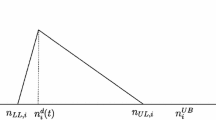Abstract
The most valuable asset of a professional service firm is its people. Owing to the high labor turnover, staffing decision is very critical in its operations. We take engineering consultancy as a professional service and emphasize the importance of developing knowledge stock of skilled consultants in a planned manner for efficient productivity management. Our focus is management of knowledge-mix, which is the mix of consultants at different productivity levels. Our model is designed to determine the steady-state number of consultant-mix to meet demand at a desired service level. This is done through the use of control theory and chance constrained programming.






Similar content being viewed by others
References
Barlett CA, Ghoshal S (1995) Rebuilding behavioral context: turn process reengineering into people rejuvenation. Sloan Manage Rev Fall:11–23
Bordoloi SK (1998) Flexibility, adaptability and efficiency in dynamic manufacturing systems. Dissertation, Management Department, The University of Texas at Austin, Chap. 5, pp 1–90
Bordoloi SK, Cooper WW, Matsuo H (1999) Flexibility, adaptability and efficiency in manufacturing systems. Prod Oper Manage 8(Summer):133–150
Bordoloi SK, Matsuo H (2001) Human resource planning in knowledge-intensive operations: a model for learning with stochastic turnover. Eur J Oper Res 130:169–189
Bordoloi SK (2004) Agent recruitment planning in knowledge-intensive call centers. J Serv Res 6(4):309–323
Buzacott J (1982) The fundamental principles of flexibility in manufacturing systems. In: Flexible manufacturing systems, proceedings of 1st international conference (Brighton UK), Elsevier Science Publishers, Amsterdam, pp 13–22
Charnes A, Cooper WW (1959) Chance-constrained programming. Manage Sci 6:73–79
Charnes A, Cooper WW, Niehaus RJ, Stedry A (1969) Static and dynamic assignment models with multiple objectives and some remarks on organizational design. Manage Sci 15(8):B365–B375
Charnes A, Cooper WW, Niehaus RJ (1970) A generalized network model for training and recruiting decisions in manpower planning. Manpower and Management Science, The English Universities Press Ltd, London
Denardo E, Tang CS (1992) Linear control of a Markov production system. Oper Res 40(2):259–278
Dorroh JR, Gulledge TR, Womer NK (1994) Investment in knowledge: a generalization of learning by experience. Manage Sci 40(8):947–958
Ebert RJ (1976) Aggregate planning with learning curve productivity. Manage Sci 23(2):171–182
Fitzsimmons JA, Fitzsimmons MJ (2000)Service management: operations, strategy and information technology, 3rd edn. McGraw-Hill Inc., New York, pp. 6–7
Gaimon C (1997) Planning information technology—knowledge worker system. Manage Sci 43(9):1308–1328
Gaiman C, Thompson GL (1984) A distributed parameter cohort personnel planning model that uses cross-sectional data. Manage Sci 30(6):750–764
Gerchak Y, Parlar M, Sengupta SS (1990) On manpower planning in the presence of learning. Eng Costs Prod Econ 20:295–303
Gong L, Matsuo H (1997) Control policy for a manufacturing system with random yield and rework. J Optim Theory Appl 95(1):149–175
Grinold RC (1976) Manpower planning with uncertain requirements. Oper Res 24(3):387–399
Hammer M, Champy J (1993) Reengineering the corporation: a manifesto of business revolution. Harper Business, New York
Holt CC, Modigliani F, Muth JF, Simon HA (1960) Planning production, inventories, and work force. Prentice-Hall, Englewood Cliffs NY
Maister DH (1982) Balancing the professional service firm. Sloan Manage Rev Fall:15–29
Sethi AK, Sethi SP (1990) Flexibility in manufacturing: a survey. Int J Flexibility Manuf Syst 2:289–328
Upton DM (1995) Flexibility as process mobility: the management of plant capabilities for quick response manufacturing. J Oper Manage 12:205–224
Author information
Authors and Affiliations
Corresponding author
Rights and permissions
About this article
Cite this article
Bordoloi, S.K. A control rule for recruitment planning in engineering consultancy. J Prod Anal 26, 147–163 (2006). https://doi.org/10.1007/s11123-006-0010-x
Published:
Issue Date:
DOI: https://doi.org/10.1007/s11123-006-0010-x




